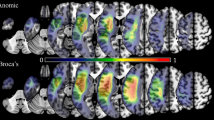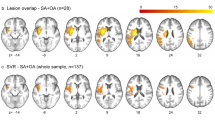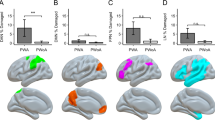Abstract
It is debated how language and praxis are co-represented in the left hemisphere (LH). As voxel-based lesion-symptom mapping in LH stroke patients with aphasia and/or apraxia may contribute to this debate, we here investigated the relationship between language and praxis deficits at the behavioral and lesion levels in 50 sub-acute stroke patients. We hypothesized that language and (meaningful) action are linked via semantic processing in Broca’s region. Behaviorally, half of the patients suffered from co-morbid aphasia and apraxia. While 24 % (n = 12) of all patients exhibited aphasia without apraxia, apraxia without aphasia was rare (n = 2, 4 %). Left inferior frontal, insular, inferior parietal, and superior temporal lesions were specifically associated with deficits in naming, reading, writing, or auditory comprehension. In contrast, lesions affecting the left inferior frontal gyrus, premotor cortex, and the central region as well as the inferior parietal lobe were associated with apraxic deficits (i.e., pantomime, imitation of meaningful and meaningless gestures). Thus, contrary to the predictions of the embodied cognition theory, lesions to sensorimotor and premotor areas were associated with the severity of praxis but not language deficits. Lesions of Brodmann area (BA) 44 led to combined apraxic and aphasic deficits. Data suggest that BA 44 acts as an interface between language and (meaningful) action thereby supporting parcellation schemes (based on connectivity and receptor mapping) which revealed a BA 44 sub-area involved in semantic processing.





Similar content being viewed by others
Abbreviations
- ACA:
-
Anterior cerebral artery
- BA:
-
Brodmann area
- FWE:
-
Family-wise error
- IFG:
-
Inferior frontal gyrus
- IPL:
-
Inferior parietal lobe
- LH:
-
Left hemisphere
- MCA:
-
Middle cerebral artery
- MNI:
-
Montreal neurological institute
- MPM:
-
Maximum probability map
- PCA:
-
Posterior cerebral artery
- SMG:
-
Supramarginal gyrus
- SPM:
-
Statistical parametric mapping
- SPSS:
-
Statistical package for the social sciences
- STG:
-
Superior temporal gyrus
- VLSM:
-
Voxel-based lesion-symptom mapping
- WM:
-
Working memory
References
Amunts K, Schleicher A, Bürgel U, Mohlberg H, Uylings HBM, Zilles K (1999) Broca’s region revisited: cytoarchitecture and intersubject variability. J Comp Neurol 412:319–341
Amunts K, Weiss PH, Mohlberg H, Pieperhoff P, Eickhoff S, Gurd J, Marshall JC, Shah NJ, Fink GR, Zilles K (2004) Analysis of neural mechanisms underlying verbal fluency in cytoarchitectonically defined stereotaxic space: the roles of Brodmann areas 44 and 45. Neuroimage 22:42–56
Amunts K, Lenzen M, Friederici AD, Schleicher A, Morosan P, Palomero-Gallagher N, Zilles K (2010) Broca’s region: novel organizational principles and multiple receptor mapping. PLoS Biol 8:e1000489
Bartolo A, Cubelli R, Della Sala S, Drei S (2003) Pantomimes are special gestures which rely on working memory. Brain Cogn 53:483–494
Bates E, Wilson SM, Saygin AP, Dick F, Sereno MI, Knight RT, Dronkers NF (2003) Voxel-based lesion-symptom mapping. Nat Neurosci 6:448–450
Binkofski F, Buccino G (2004) Motor functions of the Broca’s region. Brain Lang 89:362–369
Binkofski F, Buxbaum LJ (2013) Two action systems in the human brain. Brain Lang 127:222–229
Bogousslavsky J, van Melle G, Regli F (1988) The Lausanne stroke registry: analysis of 1000 consecutive patients with first stroke. Stroke 19:1083–1092
Buccino G, Binkofski F, Riggio L (2004) The mirror neuron system and action recognition. Brain Lang 89:370–376
Caspers S, Zilles K, Laird AR, Eickhoff SB (2010) ALE meta-analysis of action observation and imitation in the human brain. Neuroimage 50:1148–1167
Clos M, Amunts K, Laird AR, Fox PT, Eickhoff SB (2013) Tackling the multifunctional nature of Broca’s region meta-analytically: co-activation-based parcellation of area 44. Neuroimage 83:174–188
De Ajuriaguerra J, Hecaen H, Angelergues R (1960) Les apraxies. Varietes cliniques et lateralisation lesionelle. Revue Neurologique 102:566–594
De Renzi E, Motti F, Nichelli P (1980) Imitating gestures. A quantitative approach to ideomotor apraxia. Arch Neurol 37:6–10
Donkervoort M, Dekker J, Deelman BG (2006) The course of apraxia and ADL functioning in left hemisphere stroke patients treated in rehabilitation centres and nursing homes. Clin Rehabil 20:1085–1093
Dovern A, Fink GR, Saliger J, Karbe H, Koch I, Weiss PH (2011) Apraxia impairs intentional retrieval of incidentally acquired motor knowledge. J Neurosci 31:8102–8108
Eickhoff SB, Stephan KE, Mohlberg H, Grefkes C, Fink GR, Amunts K, Zilles K (2005) A new SPM toolbox for combining probabilistic cytoarchitectonic maps and functional imaging data. Neuroimage 25:1325–1335
Eickhoff SB, Bzdok D, Laird AR, Roski C, Caspers S, Zilles K, Fox PT (2011) Co-activation patterns distinguish cortical modules, their connectivity and functional differentiation. Neuroimage 57:938–949
Fazio P, Cantagallo A, Craighero L, D’Ausilio A, Roy AC, Pozzo T, Calzolari F, Granieri E, Fadiga L (2009) Encoding of human action in Broca’ area. Brain 132:1980–1988
Fridriksson J, Fillmore P, Guo D, Rorden C (2014) Chronic Broca’s aphasia is caused by damage to Broca’s and Wernicke’s areas. Cereb Cortex. doi:10.1093/cercor/bhu152
Friederici AD, Bahlmann J, Heim S, Schubotz RI, Anwander A (2006) The brain differentiates human and non-human grammars: functional localization and structural connectivity. Proc Nat Acad Sci 103:2458–2463
Goldenberg G, Karnath H-O (2006) The neural basis of imitation is body part specific. J Neurosci 26:6282–6287
Goldenberg G, Spatt J (2009) The neural basis of tool use. Brain 132:1645–1655
Goldenberg G, Hermsdörfer J, Glindemann R, Rorden C, Karnath H-O (2007) Pantomime of tool use depends on integrity of left inferior frontal cortex. Cereb Cortex 17:2769–2776
Hagoort P (2005) On Broca, brain, and binding: a new framework. Trends Cogni Sci 9:416–423
Heim S, Eickhoff SB, Opitz B, Friederici AD (2006) BA 44 in Broca’s area supports syntactic gender decisions in language production. Neuroreport 17:1097–1101
Heim S, Eickhoff SB, Ischebeck AK, Supp G, Amunts K (2007) Modality-independent involvement of the left BA 44 during lexical decision making. Brain Struct Funct 212:95–106
Heiser M, Iacoboni M, Maeda F, Marcus J, Mazziotta JC (2003) The essential role of Broca’s area in imitation. Eur J Neurosci 17:1123–1128
Higuchi S, Chaminade T, Imamizu H, Kawato M (2009) Shared neural correlates for language and tool use in Broca’s area. Neuroreport 20:1376–1381
Hillis AE, Wityk RJ, Barker PB, Beauchamp NJ, Gailloud P, Murphy K, Cooper O, Metter EJ (2002) Subcortical aphasia and neglect in acute stroke: the role of cortical hypoperfusion. Brain 125:1094–1104
Kaesberg S, Fink GR, Kalbe E (2013a) Neuropsychological assessment EARLY after stroke: an overview of diagnostic instruments available in German and introduction of a new screening tool. Fortschr Neurol Psychiatr 81:482–492
Kaesberg S, Kalbe E, Finis J, Kessler J, Fink GR (2013b) Kölner neuropsychologisches screening für Schlaganfall-Patienten (KöpSS). Hogrefe Verlag, Göttingen
Kalénine S, Buxbaum LJ, Coslett HB (2010) Critical brain regions for action recognition: lesion symptom mapping in left hemisphere stroke. Brain 133:3269–3280
Kertesz A, Ferro JM, Shewan CM (1984) Apraxia and aphasia: the functional-anatomical basis for their dissociation. Neurology 34:40–47
Kimberg DY, Coslett HB, Schwartz MF (2007) Power in voxel-based lesion-symptom mapping. J Cogn Neurosci 19:1067–1080
Kühn S, Brass M, Gallinat J (2013) Imitation and speech: commonalities within Broca’s area. Brain Struct Funct 218:1419–1427
Kümmerer D, Hartwigsen G, Kellmeyer P, Glauche V, Mader I, Klöppel S, Suchan J, Karnath H-O, Weiller C, Saur D (2013) Damage to ventral and dorsal language pathways in acute aphasia. Brain 136:619–629
Laska AC, Hellblom A, Murray V, Kahan T, von Arbin M (2001) Aphasia in acute stroke and relation to outcome. J Intern Med 249:413–422
Mengotti P, Corradi-Dell’Acqua C, Negri GA, Ukmar M, Pesavento V, Rumiati RI (2013) Selective imitation impairments differentially interact with language processing. Brain 136:2602–2618
Nelissen N, Pazzaglia M, Vandenbulcke M, Sunaert S, Fannes K, Dupont P, Aglioti S, Vandenberghe R (2010) Gesture discrimination in primary progressive aphasia: the intersection between gesture and language processing pathways. J Neurosci 30:6334–6341
Nishitani N, Schürmann M, Amunts K, Hari R (2005) Broca’s region: from action to language. Physiology 20:60–69
Papagno C, Della Sala S, Basso A (1993) Ideomotor apraxia without aphasia and aphasia without apraxia: the anatomical support for a double dissociation. J Neurol Neurosurg Psychiatry 56:286–289
Pazzaglia M, Smania N, Corato E, Aglioti SM (2008) Neural underpinnings of gesture discrimination in patients with limb apraxia. J Neurosci 28:3030–3041
Pulvermüller F, Fadiga L (2010) Active perception: sensorimotor circuits as a cortical basis for language. Nat Rev Neurosci 11:351–360
Randerath J, Goldenberg G, Spijkers W, Li Y, Hermsdörfer J (2010) Different left brain regions are essential for grasping a tool compared with its subsequent use. Neuroimage 53:171–180
Rizzolatti G, Arbib MA (1998) Language within our grasp. Trends in Neuroscience 21:188–194
Rizzolatti G, Craighero L (2004) The mirror-neuron system. Annual Review. Neurosciences 27:169–192
Roby-Brami A, Hermsdörfer J, Roy AC, Jacobs S (2012) A neuropsychological perspective on the link between language and praxis in modern humans. Philos Trans Royal Soc London B 367:144–160
Rogalsky C, Matchin W, Hickok G (2008) Broca’s area, sentence comprehension, and working memory: an fMRI study. Front Hum Neurosci. doi:10.3389/neuro.09.014.2008
Rumiati RI, Tessari A (2002) Imitation of novel and well-known actions. The role of short-term memory. Exp Brain Res 142:425–433
Rumiati RI, Weiss PH, Tessari A, Assmus A, Zilles K, Herzog H, Fink GR (2005) Common and differential neural mechanisms supporting imitation of meaningful and meaningless actions. J Cogn Neurosci 17:1420–1431
Saur D, Kreher BW, Schnell S, Kümmerer D, Kellmeyer P, Vry M-S, Umarova RM, Musso M, Glauche V, Abel S, Huber W, Rijntjes M, Hennig J, Weiller C (2008) Ventral and dorsal pathways for language. Proc Nat Acad Sci 105:18035–18040
Saygin AP, Wilson SM, Dronkers NF, Bates E (2004) Action comprehension in aphasia: linguistic and non-linguistic deficits and their lesion correlates. Neuropsychologia 42:1788–1804
Schnur T, Schwartz MF, Kimberg DY, Hirshorn E, Coslett HB, Thompson-Schill SL (2009) Localizing interference during naming: convergent neuroimaging and neuropsychological evidence for the function of Broca’s area. Proc Nat Acad Sci 106:322–327
Schwartz MF, Faseyitan O, Kim J, Coslett HB (2012) The dorsal stream contribution to phonological retrieval in object naming. Brain 135:3799–3814
Tessari A, Canessa N, Ukmar M, Rumiati RI (2007) Neuropsychological evidence for a strategic control of multiple routes in imitation. Brain 130:1111–1126
van Schie HT, Toni I, Bekkering H (2006) Comparable mechanisms for action and language: neural systems behind intentions, goals, and means. Cortex 42:495–498
Vossel S, Weiss PH, Eschenbeck P, Saliger J, Karbe H, Fink GR (2012) The neural basis of anosognosia for spatial neglect after stroke. Stroke 43:1954–1956
Wahlund LO, Barkhof F, Fazekas F, Bronge L, Augustin M, Sjögren M, Wallin A, Ader H, Leys D, Pantoni L, Pasquier F (2001) A new rating scale for age-related white matter changes applicable to MRI and CT. Stroke 32:1318–1322
Weisberg LA (1988) Diagnostic classification of stroke, especially lacunes. Stroke 19:1071–1073
Weiss PH, Dohle C, Binkofski F, Schnitzler A, Freund H, Hefter H (2001) Motor impairment in patients with parietal lesions: disturbances of meaningless arm movement sequences. Neuropsychologia 39:397–405
Weiss PH, Achilles E, Moos K, Hesse MD, Sparing R, Fink GR (2013) Transcranial direct current stimulation (tDCS) of left parietal cortex facilitates gesture processing in healthy subjects. J Neurosci 33:19205–19211
Wilke M, de Haan B, Juenger H, Karnath H-O (2011) Manual, semi-automated, and automated delineation of chronic brain lesions: a comparison of methods. Neuroimage 56:2038–2046
Willems RM, Hagoort P (2007) Neural evidence for the interplay between language, gesture and action: a review. Brain Lang 101:278–289
Willems RM, Hagoort P (2009) Broca’s region: battles are not won by ignoring half of the facts. Trends Cogn Sci 13:101
Willems RM, Özyürek A, Hagoort P (2009) Differential roles for left inferior frontal and superior temporal cortex in multimodal integration of action and language. Neuroimage 47:1992–2004
Acknowledgments
The authors would like to thank their colleagues of the Cognitive Neuroscience division (INM-3), especially Dr. Anna Dovern. Support from the Marga and Walter Boll Stiftung to GRF is gratefully acknowledged.
Author information
Authors and Affiliations
Corresponding author
Additional information
P. H. Weiss and S. D. Ubben contributed equally to this work and thus share the first authorship.
Rights and permissions
About this article
Cite this article
Weiss, P.H., Ubben, S.D., Kaesberg, S. et al. Where language meets meaningful action: a combined behavior and lesion analysis of aphasia and apraxia. Brain Struct Funct 221, 563–576 (2016). https://doi.org/10.1007/s00429-014-0925-3
Received:
Accepted:
Published:
Issue Date:
DOI: https://doi.org/10.1007/s00429-014-0925-3




